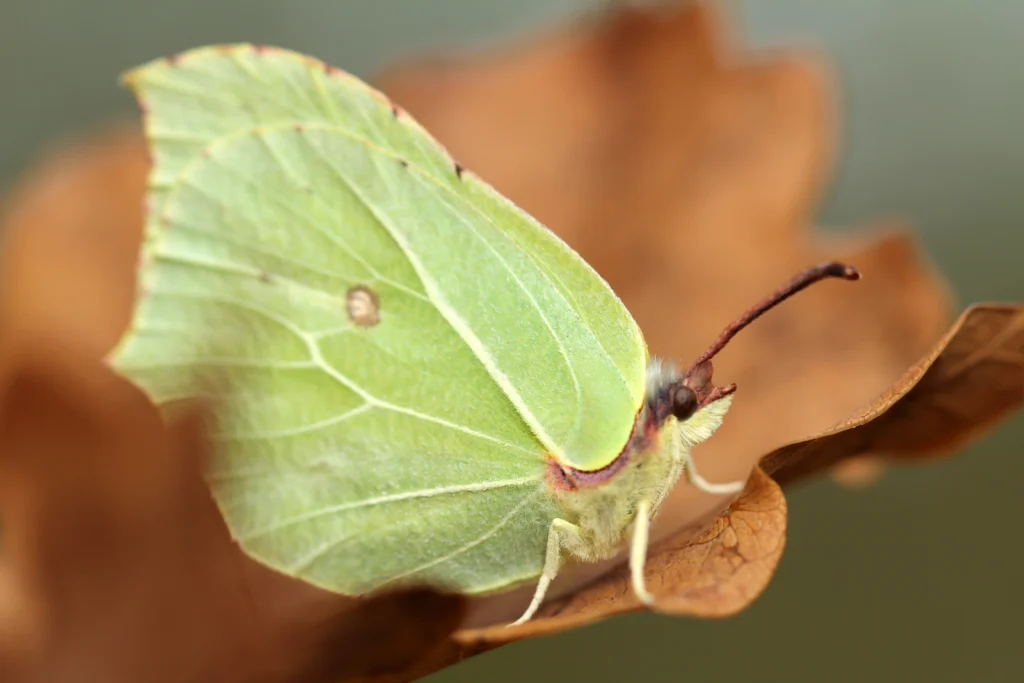“The butterfly’s flight is a dance of freedom and a celebration of transformation.” – Anonymous
The Brimstone butterfly, scientifically named Gonepteryx rhamni, is a symbol of transformation and spiritual significance respectively. Its yellow wings span 5-6 cm, making it easily identifiable from afar. Found across Europe, parts of Asia, and North Africa, the Brimstone butterfly is known to live in a variety of habitats, embodying resilience and adaptability in its life cycle. Brimstone butterfly meaning and symbolisms are as follows:
Symbolism and Spiritual Meaning
“Butterflies are the gentle reminders that beauty and grace are found in the simplest of transformations.” – Anonymous
In cultural and spiritual contexts, the Brimstone butterfly holds earnest symbolisms. Its yellow color, a symbol of joy, positivity, and spiritual growth. This butterfly and other butterflies like this one are seen as a representation of the soul’s journey. The Brimstone butterfly also signifies change and the cyclical nature of life, resonating across various traditions.
Facts and Features
“The butterfly is nature’s symbol of endurance, reminding us that the greatest changes come from within.” – Anonymous
- Brimstones have pale yellow wings with distinctive, leaf-shaped outlines. Males are lemon-yellow, while females are greenish-white with orange spots on each wing. They rest with their wings closed.
- You’ll find them in damp woodlands, sunny woodland rides, mature hedgerows, and large gardens.
- The larvae feed on buckthorn and alder buckthorn leaves.
- They’re widespread across most of England, Wales, and Ireland.
- The male’s bright yellow wings inspired the name “butterfly”
- These butterflies are known for their longevity among butterflies, often living up to 10–12 months.
- The Brimstone butterfly stands out not only for its appearance but also for its significance in ecosystems and cultural narratives.
- Unlike some butterflies, it is not poisonous, adding to its allure and positive symbolism.
Physical Description
“Butterflies are the whispers of angels, bringing messages of beauty and transformation.” – Anonymous
The Brimstone butterfly holds a wingspan of 6.0-7.4cm, with wings that resemble the shape and veining of a leaf. This resemblance (of a leaf) provides camouflage when the butterfly is resting. Males are of lemon-yellow color, while the females display a color more greenish-white color with orange spots in the middle of each wing. Both sexes have a grayish body and vein-y, pointed wings that contribute to their unique appearance.
Habitat and Distribution
“Every butterfly is a journey, a story of growth and renewal written on delicate wings.” – Anonymous
Brimstones are commonly found in damp woodlands, along sunny woodland rides, in mature hedgerows, and large gardens. In the British Isles, they are particularly infested in Northern England and parts of Ireland, such as County Clare, Galway, and the Burren region. These butterflies prefer habitats which are lime-rich soils, boggy areas, alkaline peat, and calcareous soils.
Lifecycle and Behavior
“The butterfly’s beauty is a reflection of the beauty that can emerge from within us all.” – Anonymous
The lifecycle of the Brimstone butterfly includes four stages: eggs, larvae, pupae, and adults. The breeding cycle of this butterfly begins in late March, with eggs laid on the leaves of buckthorn and alder buckthorn. A notable feature of Brimstone butterflies is reproductive diapause, where development is temporarily stopped to survive unfavorable conditions. Adults hibernate through winter, often waking up on warm days to continue their lifecycle. Their behavior and survival are influenced by weather conditions, making them adaptable to different climates.
Diet and Resource Needs
“Butterflies remind us that life is about embracing change and finding beauty in every phase.” – Anonymous
The larvae of Brimstone butterfly feeds on buckthorn (Rhamnus cathartica) and alder buckthorn (Frangula alnus). As adults, they themselves feed on nectar from flowers, as well as fruit and tree sap. Maintaining weight during summer and autumn is important for their survival during the hibernation period.
Conservation Status
“Butterflies are nature’s way of showing us that the most beautiful things in life often come from the most unexpected places.” – Anonymous
Currently, the Brimstone butterfly is considered common, although its presence can vary regionally. Conservation efforts are in place to protect their habitats, such as the 1985 Wildlife Order in Northern Ireland.
Ecological Significance and Symbolism
“The butterfly’s journey is a gentle reminder that patience and persistence can lead to extraordinary outcomes.” – Anonymous
Brimstones are important pollinators and integral parts of the food web. They hold various symbolic meanings in different cultures, often associated with transformation and new beginnings. Observing these butterflies connects people to nature and underscores the importance of environmental conservation.
Threats and Challenges
“Butterflies are the gentle poets of the garden, spreading beauty with every flutter.” – Anonymous
The Brimstone butterfly faces different environmental threats, including habitat loss, climate change, and pollution. Declining daylight hours also impact their reproductive development and egg-laying cycles. Challenges for conservation of these butterflies emphasizes the need for habitat preservation to ensure their continued survival.
Interesting Facts and Observations
“The butterfly’s delicate wings are symbols of the strength and resilience that lies within.” – Anonymous
Brimstones exhibit unique traits like protective coloration and iridescence. Records show mass emergence events that add to their intrigue. Prominent researchers such as Gutiérrez, Wilson, Harding, Nash, Boyd, Hardiman, Nelson, Thompson, Wiklund, Lindfors, and Forsberg have contributed significantly to the understanding of this species.
Conclusion
“Butterflies inspire us to let go of the past and embrace the possibilities of the future.” – Anonymous
The Brimstone butterfly is a remarkable species with significant ecological and cultural importance. Conservation efforts are crucial to protect their habitats and ensure their survival. By appreciating and observing Brimstone butterflies in their natural environments, we can create a deeper connection with nature and contribute to their preservation.
References
- Gutiérrez, D., & Wilson, R. J. (2014). Climate conditions and resource availability drive return elevational migrations in a single-brooded insect. Oecologia, 175(3), 861–873. doi:10.1007/s00442-014-2952-4
- Harding, J. (2021). The Irish Butterfly Book. Privately published, Maynooth.
- Learnaboutbutterflies.com
- Nash, D., Boyd, T., and Hardiman, D. (2012). Ireland’s Butterflies: A Review. Dublin Naturalists’ Field Club, Dublin.
- Nelson, B., and Thompson, R. (2006). The Butterflies and Moths of Northern Ireland. National Museums, Northern Ireland, Belfast.
- Oates, M. (2015). In Pursuit of Butterflies. Bloomsbury, New York.
- Wiklund, C., Lindfors, V., & Forsberg, J. (1996). Early Male Emergence and Reproductive Phenology of the Adult Overwintering Butterfly, Gonepteryx rhamni in Sweden. Oikos, 75(2), 227.

